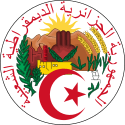Algerian dinar
The dinar (Arabic: دينار, Berber language: Dinar or Menkuc, French Dinar; sign: DA; ISO 4217 code: DZD) is the monetary currency of Algeria and it is subdivided into 100 centimes. Centimes are now obsolete due to their extremely low value.
| Algerian dinar | |||||
|---|---|---|---|---|---|
| Dinar Adzayri (Berber languages) Menkuc Adzayri (Berber languages) Dinar algérien (French) دينار جزائري (Arabic) | |||||
| |||||
| ISO 4217 | |||||
| Code | DZD | ||||
| Denominations | |||||
| Subunit | |||||
| 1⁄100 | centime; santeem (defunct) | ||||
| Symbol | دج (Arabic) or DA (Latin) | ||||
| Banknotes | |||||
| Freq. used | 200, 500, 1000 dinars | ||||
| Rarely used | 100, 2000 dinars | ||||
| Coins | |||||
| Freq. used | 5, 10, 20, 50, 100, 200 dinars | ||||
| Rarely used | 1, 2 dinars | ||||
| Demographics | |||||
| User(s) | |||||
| Issuance | |||||
| Central bank | Bank of Algeria | ||||
| Website | www | ||||
| Valuation | |||||
| Inflation | 4.1% | ||||
| Source | The World Factbook, 2009 est. | ||||
Etymology
The name "dinar" is ultimately derived from the Roman denarius.[1] The Arabic word santeem comes from the French "centime", since Algeria was under French occupation from 1830 to 1962
History
The dinar was introduced on 1 April 1964, replacing the Algerian new franc at par. By 1980s, French inscriptions saw decline on these banknotes.
Argotic counting system
The masses rarely use the dinar as such, but the franc (officially the centime; one hundredth of a dinar) and the doro (one twentieth of a dinar). In traditional selling places such as the vegetable market or in the case of street vendors, prices are displayed in francs, in more modern shops the prices are displayed in dinars but the franc is used in speech.
Coins
In 1964, coins in denominations of 1, 2, 5, 10, 20 and 50 centimes, and 1 dinar were introduced, with the 1, 2 and 5 centimes struck in aluminium, the 10, 20 and 50 centimes in aluminium bronze and the 1 dinar in cupro-nickel. The obverses showed the emblem of Algeria, while the reverses carried the values in Eastern Arabic numerals. In later decades, coins were issued sporadically with various commemorative subjects. However, the 1 and 2 centimes were not struck again, whilst the 5, 10 and 20 centimes were last struck in the 1980s.
In 1992, a new series of coins was introduced consisting of 1⁄4, 1⁄2, 1, 2, 5, 10, 20, 50 and 100 dinars. A 200 dinar bi-metallic coin was issued in 2012 to commemorate Algeria's 50th anniversary of independence.[2] The 10, 20, 50, 100, and 200 dinar coins are bimetallic.
Coins in general circulation are 5 dinars and higher. Following the massive inflation which accompanied the slow transition to a more capitalist economy during the late 1990s, the centime and fractional dinar coins have dropped out of general circulation, whilst the 1 and 2 dinar coins are rarely used, as prices are rounded to the nearest 5 dinars. Nonetheless, prices are typically quoted in centimes in everyday speech; thus a price of 100 dinars is read as عشر الاف ("ten thousand").
 2 centimes, minted in 1964
2 centimes, minted in 1964 5 centimes, minted in 1974
5 centimes, minted in 1974 10 centimes, minted in 1984, a palm tree
10 centimes, minted in 1984, a palm tree 20 centimes, minted in 1972, an overflowing cornucopia depicting the theme of agricultural revolution
20 centimes, minted in 1972, an overflowing cornucopia depicting the theme of agricultural revolution
 50 centimes, minted in 1975, "The 30th remembering" in Arabic and commemorating the French Algerian Clash
50 centimes, minted in 1975, "The 30th remembering" in Arabic and commemorating the French Algerian Clash

 5 dinar, minted in 1974, an Algerian soldier and commemorating the 20th anniversary of the Revolution
5 dinar, minted in 1974, an Algerian soldier and commemorating the 20th anniversary of the Revolution 10 dinar, minted since 1979, "Bank of Algeria" in Arabic
10 dinar, minted since 1979, "Bank of Algeria" in Arabic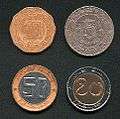 Current 20 and 50 dinar and obsolete 5 and 10 dinar coins
Current 20 and 50 dinar and obsolete 5 and 10 dinar coins
Banknotes
The first series of dinar banknotes issued in 1964 consisted of banknotes in denominations of 5-, 10-, 50- and 100 dinars. In 1970, 500 dinar banknotes were added, followed by 1000 dinars in 1992.
| Third series | |||||||
|---|---|---|---|---|---|---|---|
| Image | Value | Main Colour | Description | Date of | |||
| Obverse | Reverse | Obverse | Reverse | printing | issue | ||
| 10 DA | Green | Diesel passenger train | Mountain village | 2 December 1983 | |||
| 20 DA | Red | Amphora and Arch | Handcrafts and tower | 2 January 1983 | |||
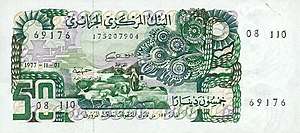 |
50 DA | Green | Shepherd with flock | Farmers on a tractor | 1 November 1977 | ||
 |
100 DA | Blue | Village with minarets | Man working with plants | 1 November 1981 8 June 1982 |
||
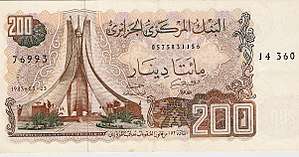 |
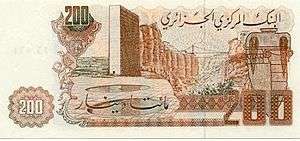 |
200 DA | Brown | Place of the Martyrs, Algiers | One of the various bridges of Constantine | 23 March 1983 | |
| Fourth series | |||||||
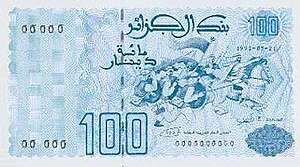 |
100 DA | Blue | Charging Arab horse riders with sabres in a seal, and Algerian navy in a battle | Pre-colonial invasion: Battle of El Harrach (1775) victory of the Algerian horseriders over the invading Spanish. | 21 May 1992 | 1996 | |
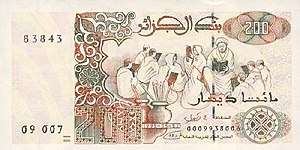 |
 |
200 DA | Reddish Brown | Decorative Koranic motifs and symbols, mosque, olive and fig branches | Period Islam Introduced: Traditional Koranic school and Kalam | ||
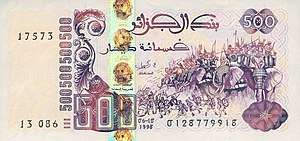 |
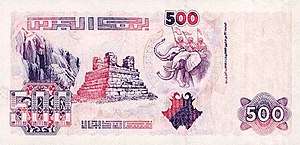 |
500 DA | Violet and pink | Numidian Period: Battle on elephants between Numidians and invading Romans | Romans fighting, a gasing in Tipaza, a hot waterfall in Hammam Debagh, Guelma Province (?) | 21 May 1992 10 June 1998 |
1996 2000 |
| 500 DA | Violet and pink | Globe, Alcomsat-1 (Algeria's first communication's satellite) | Satellite dishes, outline of Algeria, bridge | 1 November 2018 2018 |
2018 2018 | ||
 |
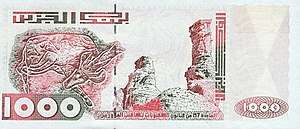 |
1000 DA | Red and brown | Prehistory of Algeria: A buffalo, paintings at Tassili n'Ajjer | More paintings from the Tassili, and the Hoggar (?) | 21 May 1992 10 June 1998 |
1995 2000 |
| 1000 DA | Blue and Red | Grand mosque of Algiers | Loom, teapot | 1 December 2018 2018 |
2018 2018 | ||
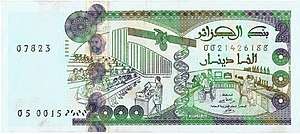 |
 |
2000 DA | Purple and green | University professor lecturing students in amphitheatre, satellite, double-helix DNA strand, three researchers in scientific laboratory with microscope and beakers | Wheat, palm tree, body of water, urban high-rise buildings, olive tree | 24 January 2011 2011 |
2011 2011 |
| For table standards, see the banknote specification table. | |||||||
The 100 dinar note is being replaced by coins. 200, 500, and 1000 dinar notes are in circulation. The 1998 dated 500 and 1000 dinar notes have an additional vertical holographic strip on obverse.
| Current DZD exchange rates | |
|---|---|
| From Google Finance: | AUD CAD CHF EUR GBP HKD JPY USD TRY INR CNY |
| From Yahoo! Finance: | AUD CAD CHF EUR GBP HKD JPY USD TRY INR CNY |
| From XE.com: | AUD CAD CHF EUR GBP HKD JPY USD TRY INR CNY |
| From OANDA: | AUD CAD CHF EUR GBP HKD JPY USD TRY INR CNY |
| From fxtop.com: | AUD CAD CHF EUR GBP HKD JPY USD TRY INR CNY |
See also
- Economy of Algeria
References
- Krause, Chester L.; Clifford Mishler (2003). 2004 Standard Catalog of World Coins: 1901–Present. Colin R. Bruce II (senior editor) (31st ed.). Krause Publications. ISBN 0873495934.
- Cuhaj, George S. (editor) (2006). Standard Catalog of World Paper Money: Modern Issues 1961-Present (12th ed.). Krause Publications. ISBN 0-89689-356-1.CS1 maint: extra text: authors list (link)
- Algerian Bank Regulations of 1996, for specifications of fourth series currency (French).
- http://www.monete-romane.com/roman_coins/denarius.html
- Algeria 200 dinars 2012 - 50 Years of Independence worldcoinnews.blogspot.com. Retrieved 2012-07-11.


